Video of the Week:
Bacterial Spot on Peach Trees
Ornamentals:
Rust on Hollyhock
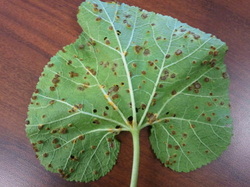
The first line of defense is to remove all hollyhock stalks, leaves and other debris in the fall and destroy them. Remove any infected foliage you see now. Just be sure the foliage is dry so you don’t spread the
disease. Continue to remove diseased leaves as soon as they show spots. Try using a fungicide such as sulfur or myclobutanil (Immunox or Immunox Plus) to protect healthy foliage. Note that sulfur may burn leaves if the air temperature is over 85 degrees within 24 hours of application. Follow label directions for timing and rate. (Ward Upham)
Vegetables:
New Potatoes
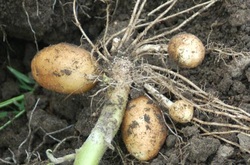
Mulching Garden Crops
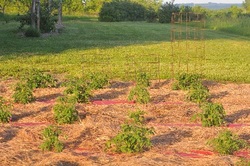
Do Not Over-Fertilize Tomatoes
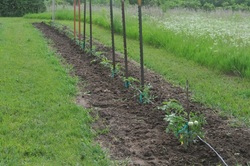
Use only one of the listed fertilizers and apply at the rate given below.
Nitrate of soda (16-0-0): Apply 2/3 pound (1.5 cups) fertilizer per 30 feet of row.
Blood Meal (12-1.5-.6): Apply 14 ounces (1.75 cups) fertilizer per 30 feet of row.
Urea (46-0-0): Apply 4 ounces (½ cup) fertilizer per 30 feet of row.
Ammonium Sulfate (21-0-0): Apply 0.5 pounds (1 cup) fertilizer per 30 feet of row.
Fruit:
Fruit Reminders
* Remove sucker growth from the base of fruit trees and grape vines.
* Remove water sprout growth from fruit trees. Water sprouts grow straight up.
* "Comb" new growth on grape vines so these new shoots hang down for greater exposure to sunlight.
* Continue disease and insect control to prevent fruit damage. (Ward Upham)
Pests:
Lecanium Scale
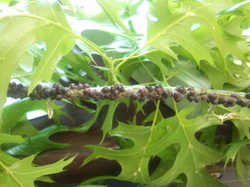
on the honeydew, can turn branches and leaves black. Branch dieback is possible with large populations. Predators and parasites normally keep lecanium scale under control, but there are times when the population of beneficials is too low to provide immediate control. Unfortunately, later instars and adults are virtually impossible to control with insecticides. Only the crawler stage is susceptible, and the time of crawler emergence varies from year to year.
If you feel insecticides are necessary, target the crawler stage as it migrates from the dead mother's body to the leaves. This usually occurs about the time yucca plants flower. Trapping adults has shown that this week is a good time to apply treatments in Wichita as the crawlers are out. Apply a followup spray in another 10 days. More northern locations may want to wait until the yucca flowers. Registered products include permethrin (numerous trade names) cyfluthrin (Tempo, Bayer Vegetable and Garden Insect Spray), dinotefuran (Ortho Tree & Shrub Insect Control Ready To Use Granules), carbaryl (Sevin) and malathion. Though too late to apply now, imidacloprid (Bayer Tree and Shrub Insect Control, Bonide Systemic Granules IC) can be applied in the fall. (Ward Upham)
Now is Time to "Nail" Those Bagworms
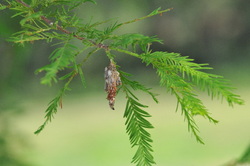
At this time of year, what is the best way to deal with bagworm caterpillars and thus prevent them from causing damage? Handpicking any small caterpillars (along with their accompanying bag) and placing them into a container of soapy water will kill them directly. This is highly therapeutic and, if feasible, will quickly remove populations before they can cause substantial plant damage. You should consider having a weekend “bagworm handpicking party” with prizes awarded to those individuals that collect the most bags. For those less interested in the pleasures of handpicking, there are a number of insecticides labeled for use against bagworms including those with the following active ingredients (trade name in parentheses): acephate (Orthene), Bacillus thuringiensis subsp. kurstaki (Dipel/Thuricide), cyfluthrin (Tempo), lambda-cyhalothrin (Scimitar), trichlorfon (Dylox), indoxacarb (Provaunt), chlorantraniliprole (Acelepryn), and spinosad (Conserve). Many of these active ingredients are commercially available and sold under different trade names or generic products. However, several insecticides may not be directly available to homeowners. The key to dealing with bagworms when using insecticides is to make applications early and frequently enough in order to kill the highly susceptible young caterpillars that are feeding aggressively on plant foliage. Older caterpillars that develop later in the season, in the bags, may be 3/4-inches long, and are typically more difficult to kill with insecticides. In addition, females tend to feed less as they prepare for reproduction, which reduces their susceptibility to spray applications and any residues. The bacterium Bacillus thuringiensis subsp. kurstaki is active on young caterpillars; however, the active ingredient must be consumed to be effective, so thorough coverage of all plant parts and frequent applications are required to avoid having to deal with later stages. This compound is sensitive to ultra-violet light degradation and rainfall, which reduces any residual activity. Spinosad is the active ingredient in a number of homeowner products (including Borer, Bagworm, Tent Caterpillar & Leafminer Spray; Captain Jack’s DeadBug Brew; and Monterey Garden Insect Spray) and works by contact and ingestion (stomach poison); however, it is most effective when ingested and it can be used against older or larger bagworm caterpillars. Cyfluthrin, lambda-cyhalothrin, trichlorfon, chlorantraniliprole, and indoxacarb may be used against both the young and the older caterpillars. However, thorough coverage of all plant parts, especially the tops of trees and shrubs, where bagworms commonly start feeding, and frequent applications are required.
The reason why multiple applications will be needed when bagworms are first detected is because bagworms “blow in” (called ‘ballooning’) from neighboring plants. If left unchecked, bagworms can cause significant
damage, thus ruining the aesthetic quality of plants. In addition, they may actually kill plants, especially evergreens since they don’t usually produce another flush of growth, and newly transplanted small plants. If you have any questions regarding the management of bagworms, contact your county horticultural agent, or university-based or state extension entomologist. (Raymond Cloyd)
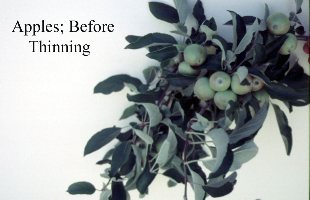
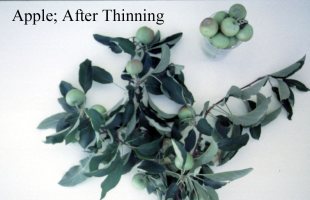
 RSS Feed
RSS Feed
